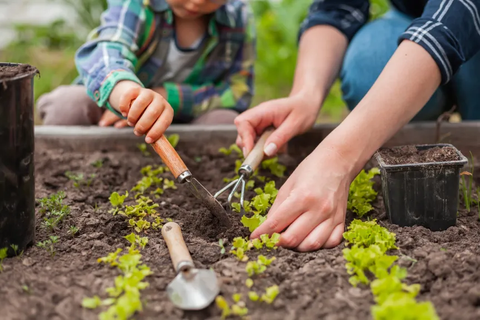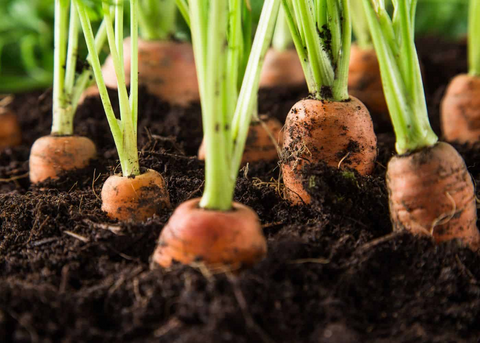Healthy soil is the foundation of a productive and thriving garden. Whether you're growing vegetables, flowers, or herbs, nutrient-rich soil provides the essential elements that plants need to grow, develop, and produce abundant yields. In this comprehensive guide, we'll explore the fundamentals of soil health, how to build nutrient-rich garden soil, and most importantly, how to maintain it for long-term success. By the end of this article, you'll have the knowledge and tools to cultivate a flourishing garden that rewards your efforts with vibrant, thriving plants. The following content also has some reference value for raised garden beds.

Understanding the Basics of Soil Health
To effectively build and maintain nutrient-rich garden soil, it's essential to understand the key components and principles of soil health:
1. Soil Composition
Soil is composed of mineral particles, organic matter, water, and air. The mineral particles are classified into three main categories based on size:
- Sand: Large particles that drain quickly but don't retain much moisture or nutrients.
- Silt: Medium-sized particles that hold moisture and nutrients moderately well.
- Clay: Small particles that retain moisture and nutrients but can become compacted and drain poorly.
The ideal garden soil, often referred to as loam soil, is a balanced mixture of these three particle types.
2. Organic Matter
The presence of organic matter is essential for healthy soil. It includes decomposed plant and animal material, such as compost, leaf mold, and well-rotted manure. Organic matter enhances the structure of the soil, increases water retention, and gives plants a source of nutrients.
3. Soil pH
On a scale from 0 to 14, soil pH determines whether the soil is acidic or alkaline. Below 7 is acidic, above 7 is alkaline, and pH 7 is neutral. With a pH range of 6 to 7.5, most plants prefer slightly acidic to neutral soil. Soil pH affects nutrient availability, so it's essential to maintain the appropriate pH for your plants.
4. Nutrients
Plants require essential nutrients for growth, including nitrogen (N), phosphorus (P), and potassium (K), as well as secondary and micronutrients like calcium, magnesium, sulfur, and iron. Healthy soil should contain an adequate supply of these nutrients for plants to thrive.
Building Nutrient-Rich Garden Soil
Now that we've covered the fundamentals, let's dive into the steps to build nutrient-rich garden soil:
1. Soil Testing
Before making any adjustments to your soil, it's crucial to conduct a soil test. Soil testing provides valuable information about your soil's current pH and nutrient levels, helping you make informed decisions about soil amendments. Many agricultural extension services offer soil testing services, or you can use at-home soil test kits.
2. Amend with Organic Matter
Organic matter is the secret sauce for nutrient-rich soil. Incorporate organic matter into your soil by:
- Composting: Create your compost pile using kitchen scraps, yard waste, and other organic materials. Once composted, mix it into your garden soil.
- Mulching: Apply a layer of organic mulch, such as straw, wood chips, or leaf mulch, to the surface of your soil. Mulch not only adds organic matter but also helps retain moisture and suppress weeds.
- Cover Cropping: Plant cover crops like clover or vetch during the off-season. These crops add organic matter when tilled into the soil.
3. Adjust pH
Based on your soil test results, you may need to adjust the pH of your garden soil:
- Acidic Soil (pH Below 6): To raise pH, add lime or wood ash. Follow the recommended application rates for your specific soil type and target pH.
- Alkaline Soil (pH Above 7.5): To lower pH, incorporate organic matter like peat moss or compost. This will make the soil more acidic over time.
4. Fertilization
Supplement your soil with essential nutrients by using organic or synthetic fertilizers. Compost, well-rotted manure, bone meal, and fish emulsion are a few examples of organic choices. Synthetic fertilizers provide specific nutrients and can be tailored to your soil's needs based on soil testing.
When applying fertilizers, follow the recommended rates and timing for different plants and growth stages. Over-fertilizing can lead to nutrient imbalances and harm beneficial soil organisms.
5. Proper Irrigation
Water management is essential for maintaining soil health. Over-watering can lead to nutrient leaching, while under-watering can stress plants. Use efficient watering techniques, such as drip irrigation or soaker hoses, to deliver water directly to the root zone and minimize evaporation.
6. Crop Rotation
To prevent nutrient depletion and disease build-up, practice crop rotation. Rotate plant families to different areas of your garden each year. For example, avoid planting tomatoes in the same spot two years in a row.

Maintaining Nutrient-Rich Garden Soil
Building nutrient-rich soil is a valuable start, but maintaining its health is an ongoing process. Here's how to ensure the long-term fertility and productivity of your garden soil:
1. Regular Soil Testing
Continuously monitor your soil by conducting regular soil tests, ideally once a year. Soil conditions can change over time, and soil testing will help you make necessary adjustments to maintain optimal nutrient levels and pH.
2. Mulch and Organic Matter
Continue to mulch your garden beds with organic matter regularly. Mulching not only conserves moisture but also provides a continuous source of organic material as it breaks down.
3. Avoid Over-Tilling
Excessive tilling or digging can disrupt the structure of your soil and damage beneficial organisms. Consider no-till or low-till gardening methods to preserve soil health.
4. Crop Rotation
Stick to a crop rotation plan to prevent soil depletion and disease. Keep records of your planting history to ensure proper rotation.
5. Beneficial Microorganisms
Encourage the growth of beneficial soil microorganisms by avoiding the use of chemical pesticides and herbicides. These chemicals can harm beneficial bacteria and fungi essential for nutrient cycling.
6. Companion Planting
Explore companion planting strategies that pair compatible plants to enhance soil health. For example, legumes like beans and peas fix nitrogen in the soil, benefiting neighboring plants.
7. Maintain Good Drainage
Proper soil drainage is essential for preventing waterlogged soil, which can lead to root rot and nutrient leaching. Ensure that your garden beds have adequate drainage, and consider raised beds for improved drainage in poorly draining soils.
Conclusion: Nurturing Your Garden's Lifeblood
Garden soil is the lifeblood of your plants, providing them with essential nutrients, water, and support. Building and maintaining nutrient-rich garden soil is a continuous process that involves careful planning, organic matter enrichment, and regular monitoring. By following the guidelines outlined in this comprehensive guide, you can create a garden that thrives and consistently produces bountiful harvests year after year. Remember that healthy soil leads to healthy plants, and healthy plants lead to a thriving, joyful garden that brings you endless satisfaction and delicious rewards.









